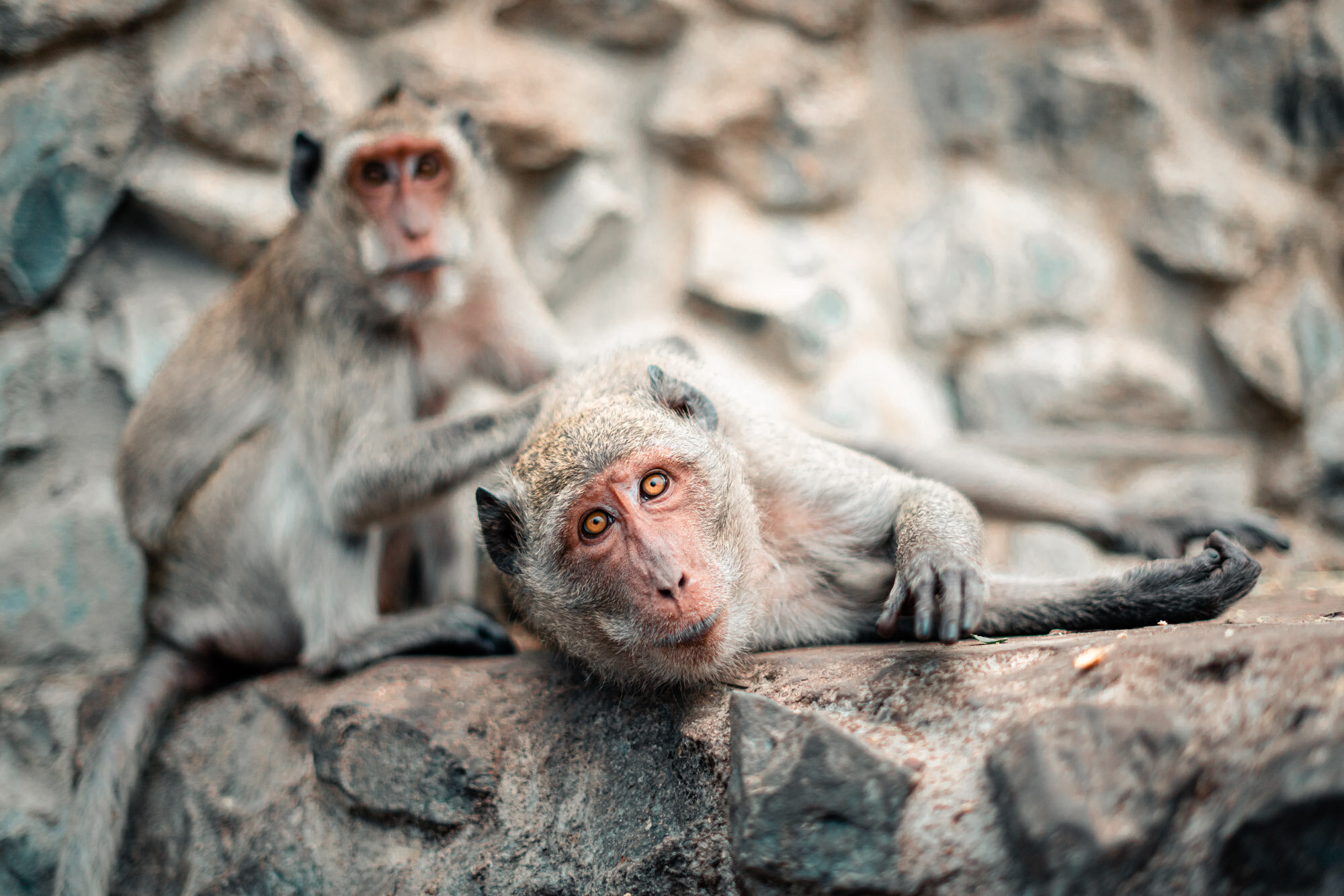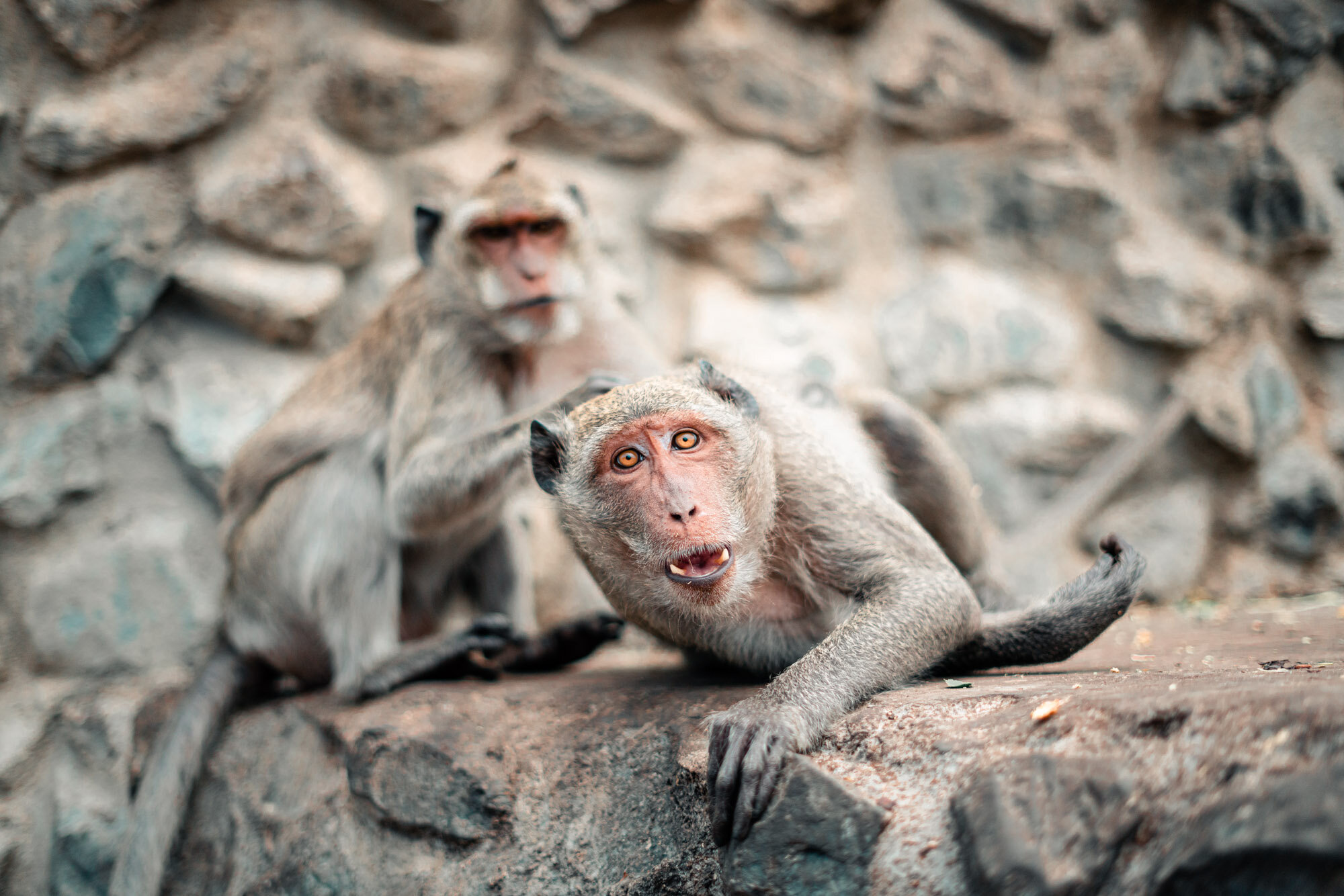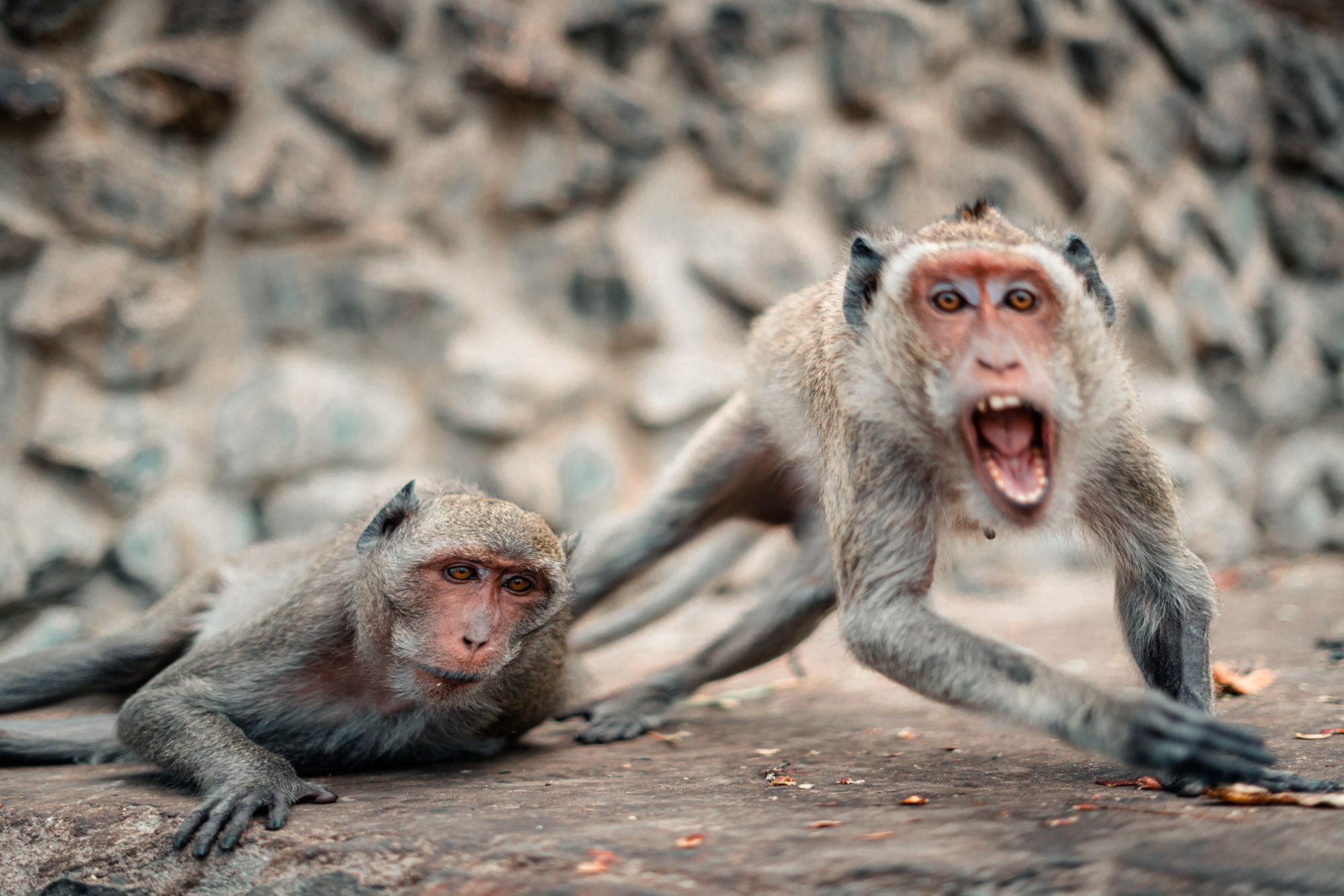5 Tips to Avoid Making Macaque Monkeys Aggressive (+ What to Do if They Get Angry)
If you’ve heard anything about the macaques in Thailand (and much of the rest of Southeast Asia), you’ve probably heard that they’re aggressive little thieves. And that’s true! If you go near them carrying anything they think looks like food, there’s a good chance you’ll find yourself mobbed and robbed. Luckily, with some pretty simple precautions and habits, you can avoid this and have a much more peaceful time around them.
When we first arrived in a Thai town full of macaques, we had to carry sticks with us and threaten to swat the monkeys away just to walk up the stairs to a hilltop temple. Now, we can walk up those same stairs without any issues, and don’t even need to carry sticks with us anymore.
1. DO NOT CARRY FOOD (or anything that looks like food)
This one should be pretty straightforward, but you might be surprised by how many people do it anyway.
If you’re carrying grocery bags from your shopping trip, or a picnic lunch, the macaques will naturally assume it’s for them and you’re just cruelly withholding it until they can get it from you. Many of them even recognize drink bottles and will steal those too.
In short: don’t carry anything that might look like you have food. This means shopping bags, paper bags, little plastic baggies, packs of pet food, etc.
Surprisingly, for us, backpacks have been fine. But your mileage may vary on that depending on the particular macaques you interact with.
This is what happens when you have food around macaques: you get swarmed.
2. Keep a neutral face
Macaques can be incredibly cute! Especially the little babies, stumble-running around and pushing limits as they peek at you from much closer than they should be.
The natural temptation is to smile at them, of course!
But to a macaque, a smiling display of teeth is a show of aggression. Imagine how you would react if your toddler ran up happily to a stranger, who then pulled out a knife and brandished it at your kid.
Of course the macaques are going to leap into action, threatening you in return.
Similarly, raised eyebrows are the first indication that macaques give when they’re warning you to back off. So simply raising your eyebrows at macaques can also come across as aggression or a threat.
As tempting as it is to interact with them since they’re so cute, keep your face as neutral as possible to avoid accidentally threatening them.
Macaque giving facial cues to back off.
3. Don’t maintain eye contact
It’s basically impossible not to ever make eye contact with macaques. We’ve found that the simple act of making eye contact in itself isn’t actually a problem (whew!).
But holding that eye contact after you make it is a problem. So if you find yourself accidentally locking eyes with a macaque, look away quickly. Maintained eye contact is a threatening act of aggression, and avoiding it is a simple way to help the monkeys see you as a harmless visitor instead of a dangerous threat.
4. Give the macaques plenty of space
Trust me, I understand the temptation to get right up close with the macaques. I wish I could pet them, play with their tails, and basically treat them like adorable puppies.
But even when they live in cities and are accustomed to human contact, monkeys are essentially wild animals. So don’t get all up in their faces or try to touch them. If one of them wants to walk close to you, that’s fine, but don’t be the one to initiate getting too close to them.
5. Move calmly and deliberately
When you’re in a city where macaques are all over the sidewalk, sometimes you can’t help but walk toward them and get very close to them as you pass.
The difference between the way locals and tourists handle this is that locals typically just walk on by, paying almost no attention to the monkeys. In return, the monkeys might cast a wary look at the person walking past, but the interaction stops there.
Tourists, on the other hand, often get super dramatic. They shriek with excitement or fear, try to run around (or toward) the monkeys, jump dramatically out of the way, and otherwise carry on with all sorts of noise and excitement. This riles the monkeys up because they’re not used to it and don’t know how to interpret it.
Calm, deliberate movements (combined with the other four tips) will help ensure that the monkeys find you as boring and uneventful as possible, which is a great way to discourage them from investigating you too closely.
Bonus tip: blink a lot.
This is a relatively new theory that we’ve come up with and have only tested a few times, but so far it seems promising.
You see, when a macaque is unavoidably close to us (on a narrow path, for example) but wants to make it clear that it’s not threatening us, we noticed that it will avert its eyes and blink frequently until it’s safely past us.
Our theory is that, since maintained eye contact is a show of aggression, this frequent blinking is a way of emphasizing that they’re not making maintained eye contact. Try this out in addition to the other five tips, and let us know if you feel like it makes a difference!
Oops, something went wrong and a macaque is mad! What now?!
If a macaque makes a surprised-looking face with an open mouth, wide eyes, and raised eyebrows, it’s angry at you and warning you to back off. If it leans forward toward you while doing this, it’s an outright threat; the next step is to run toward you and try to chase you away.
The best thing you can do at this point is back off slowly while facing the monkey, but without staring at it. It’s tempting to warily watch at the macaque as you do so (after all, why wouldn’t you keep an eye on a wild animal that’s threatening you?!), but remember that eye contact signals aggression to macaques. Do not turn around and run away.
Backing off at the first sign of anger should be all you need to do. In hundreds of interactions with macaques, there have only been two times that this hasn’t worked for us and a particularly angry macaque kept coming.
If this happens to you, again, do not give into the temptation to run away. Doing so may just encourage the monkey. Instead, if an angry macaque keeps pursuing you after you tried to back off, stop and stand your ground. Make yourself large (by waving your arms and standing up tall), make noise (try yelling “hey!” or “back off!”), and then continue to back away, always facing the monkey but without making eye contact.
What if a monkey is stealing my stuff?!
Let it go. Playing tug-of-war with a monkey is a great way to get bitten, and no matter how delicious your lunch is, it’s not worth an emergency trip to the hospital or potentially contracting serious diseases from a monkey bite.
If the monkey is holding onto something more valuable than just lunch (like your camera or phone), you have two real options. First, you can wait for the monkey to get bored and drop the item in question, then retrieve it. Second, you can try to trade the monkey something less valuable in exchange.
Once, a macaque managed to sneakily grab one of my camera lenses because I wasn’t paying enough attention. I managed to convince him to take my cheap sunglasses instead, and was able to retrieve the unharmed lens.


